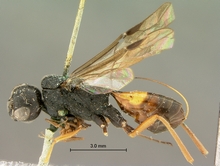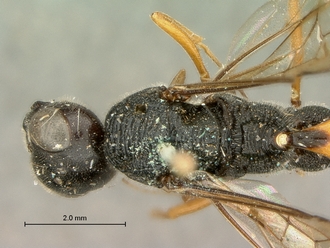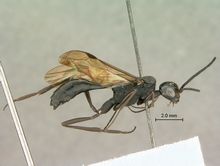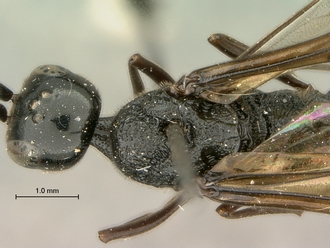|
|

a |
 |
|
1A
|
Body length
(excluding ovipositor) more than 25 mm; clypeus with a median lamella;
antennal scape elongate with a weak longitudinal carina; hairs of
mesoscutum recumbent, long and very dense; hind coxae polished and
smooth; hind tibiae enlarged and laterally compressed
... 2
|
|
1B
|
Body
length (excluding ovipositor) less than 20 mm; clypeus with a median
tooth; antennal scape globose and without a weak longitudinal carina;
hairs of mesoscutum erect, short and scattered; hind coxae more or less
sculptured; hind tibiae sub-cylindrical ...
3
|
|
2A
|
Propodeum
posteriorly with a median bulge (fig. a); vertex of head coarsely
punctured (fig. b); POL:OOL = 1.6 (fig. c); mesosternum smooth (fig.d)
... Pristaulacus
rex (Benoit,
1984).
Only
known from Democratic Republic of Congo.
|
|

a |
b |
c
|
|
2B
|
Propodeum without bulge (fig. a); vertex of head with punctures and
reticulations (fig. b); POL:OOL = 1.2 (fig. c); mesosternum coarsely
punctured (fig. d) ...
Pristaulacus
irenae (Madl,
1990).
Only
known from Kenya.
|
|
3A
|
Pronotum with a well
developed tooth on the latero-ventral margin (Fig. a); prescutum dull
and coarsely sculptured; dorsal surface of propodeum very short; petiole
very long, 5.0X (male) or 5.8X (female) as long as wide; antenna very
short, 0.6X (female) and 0.4X (male) as long as fore wing length; fore
wing with a narrow, irregular transverse spot behind stigma which
reaches the posterior margin of fore wing and a small apical spot of the
same colour (Fig. b); hind coxa with a sub-basal transverse groove
(female) (Fig. c); hind basitarsus very swollen, 6.5X (female) and 3.9X
(male) as long as wide and 1.8X as long as the following tarsomeres
together (Fig. d); mesoscutum reddish-orange with three well developed
lamellae on mesoscutum; apex of valvulae 3 of ovipositor swollen
(female) (Fig. e) ...Pristaulacus smithi Turrisi, 2006
(Mozambique, Zimbabwe) |
|
3B
|
Pronotum without tooth on
the latero-ventral margin (Fig. a); prescutum shining and smooth, at most with
punctures; dorsal surface of propodeum longer; petiole shorter; antenna longer
(0.8X or more as long as fore wing length); fore wing hyaline or uniformly
infuscate without brown spot (Fig d); hind coxa with a subapical transverse groove
(female); hind basitarsus weakly enlarged, at least 8.0X as long as wide; mesoscutum entirely black or extensively red-orange without
lamellae; apex of valvulae 3 of ovipositor not swollen (female)
....
4 (South
Africa) |
|
4A
|
Temples, from above,
1.4 as long as eye length; mesosoma with pronotum, mesoscutum and
scutellum reddish-orange; hind basitarsus yellowish-white; metasoma
entirely black ...
Pristaulacus thoracicus
(Westwood, 1841). Only known from South Africa. |
|
4B
|
Temples, from above, 0.8-1.2X
as long as eye length; mesosoma entirely black; hind basitarsus blackish or red;
metasoma entirely black or partly reddish-orange ...5 |
|

a |

b |
|
|
5A
|
Metasoma extensively
orange; prescutum without punctures; hind coxa stocky, with distal lobe
short and very wide (Fig. a) ...
Pristaulacus africanus
(Brues, 1924).
Only known from South Africa. |
|

a |

b |
|
|
5B
|
Body entirely black (in some
specimens with propodeum and first metasomal segment orange); prescutum with
coarse and well defined punctures on base; hind coxa slender, with distal lobe
long and restricted (Fig. a) ...
Pristaulacus pilatoi Turrisi, 2006.
Only known from South Africa. |
References
|
Benoit, P.L.G.
1984.
Aulacidae, famille nouvelle pour la faune de l'Afrique tropicale (Hymenoptera).
Revue de
Zoologie Africaine 98, 799-803.
Turrisi G.F. 2006. Revision of the
Afrotropical species of Pristaulacus Kieffer 1900 (Hymenoptera:
Aulacidae). Insect Systematics & Evolution 37: 27-38.
Turrisi, G.F., Jennings J.T. & Vilhelmsen, L. 2009.
Phylogeny and generic concepts of the
parasitoid wasp family Aulacidae (Hymenoptera: Evanioidea).
Invertebrate Systematics 23: 27–59.
|
|